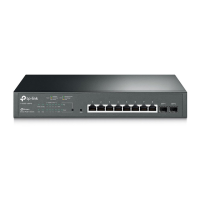TL-SL3428 JetStream L2 Managed Switch CLI Guide
161
The igmp-snooping filter-config command is used to modify the multicast
filtering IP-range.
Syntax
igmp-snooping filter-config {id} {start-ip} {end-ip}
Parameter
id —— IP-range ID, ranging from 1 to 30.
start-ip —— The start multicast IP of the IP-range.
end-ip —— The end multicast IP of the IP-range.
Command Mode
Global Configuration Mode
Example
Modify the multicast IP-range whose ID is 20 as 225.0.0.10~225.0.0.12:
TP-LINK(config)# igmp-snooping filter- config 20 225.0.0.10 225.0.0.12
igmp-snooping filter
Description
The igmp-snooping filter command is used to configure Port Filter. To return to
the default configuration, please use no igmp-snooping filter command. When
the switch receives IGMP report message, it examines the multicast filtering IP
ID configured on the access port to determine if the port can join the multicast
group. If the multicast IP is not filtered, the switch will add the port to the forward
port list of the multicast group. Otherwise, the switch will drop the IGMP report
message. In that way, you can control the multicast groups that users can
access.
Syntax
igmp-snooping filter [status [disable | enable] | mode [refuse | accept] |
addr-id [filter-addr-id] | maxgroup [max-group]]
no igmp-snooping filter
Parameter
status —— Enable/ Disable port multicast filtering function. By default, it is
disabled.
mode —— Action Mode, with refuse and accept options. Refuse indicates only
the multicast packets whose multicast IP is not in the IP-range will be processed,
while accept indicates only the multicast packets whose multicast IP is in the

